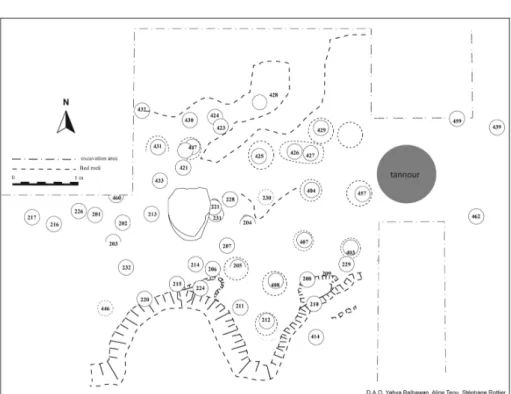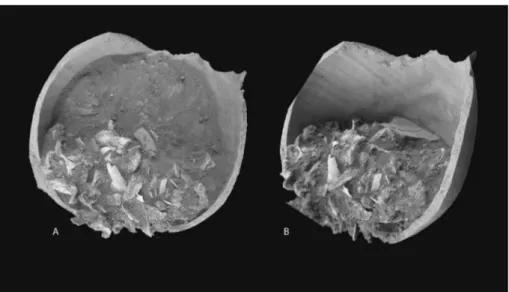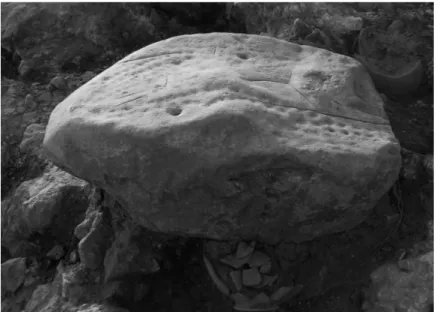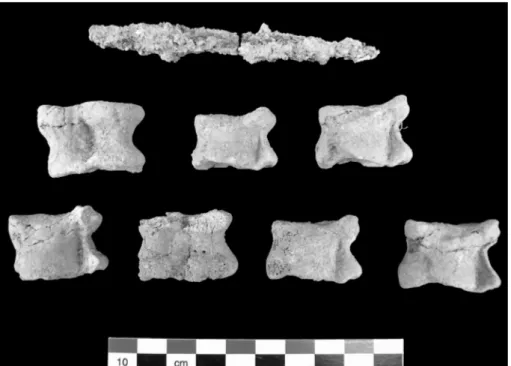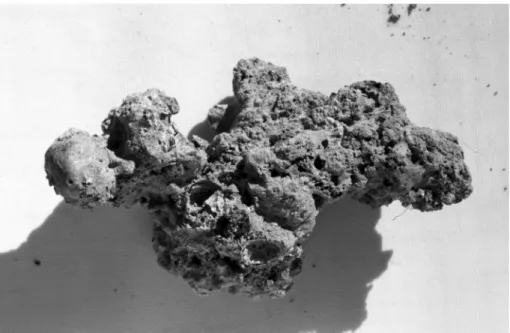HAL Id: halshs-02359906
https://halshs.archives-ouvertes.fr/halshs-02359906
Submitted on 12 Dec 2019HAL is a multi-disciplinary open access
archive for the deposit and dissemination of sci-entific research documents, whether they are pub-lished or not. The documents may come from teaching and research institutions in France or abroad, or from public or private research centers.
L’archive ouverte pluridisciplinaire HAL, est destinée au dépôt et à la diffusion de documents scientifiques de niveau recherche, publiés ou non, émanant des établissements d’enseignement et de recherche français ou étrangers, des laboratoires publics ou privés.
FIRE IN FUNERAL CONTEXTS: NEW DATA FROM
TELL AL-NASRIYAH (SYRIA)
Aline Tenu, Stéphane Rottier
To cite this version:
Aline Tenu, Stéphane Rottier. FIRE IN FUNERAL CONTEXTS: NEW DATA FROM TELL AL-NASRIYAH (SYRIA). 8th International Congress on the Archaeology of the Ancient Near East, Apr 2012, Varsovie, Poland. �halshs-02359906�
Proceedings of the 8thInternational Congress
on the Archaeology of the Ancient Near East Volume 3
Proceedings
of the 8
th
International Congress
on the Archaeology
of the Ancient Near East
30 April – 4 May 2012,
University of Warsaw
Volume 3
Archaeology of Fire,
Conservation, Preservation and Site Management,
Bioarchaeology in the Ancient Near East
Islamic Session
Selected papers from workshop sessions
Edited by
Piotr Bieliński, Michał Gawlikowski,
Rafał Koliński, Dorota Ławecka, Arkadiusz Sołtysiak
and Zuzanna Wygnańska
2014
Cover illustration: Impression of a third millennium BC cylinder seal from Tell Arbid in Syria combined with the depiction of a mermaid – a motif from Warsaw’s coat of arms. Designed by Łukasz Rutkowski.
Bibliografische Information der Deutschen Nationalbibliothek
Die Deutsche Nationalbibliothek verzeichnet diese Publikation in der Deutschen Nationalbibliografie; detaillierte bibliografi sche Daten sind im Internet über http://dnb.dnb.de abrufbar.
Bibliographic information published by the Deutsche Nationalbibliothek The Deutsche Nationalbibliothek lists this publication in the Deutsche Nationalbibliografie; detailed bibliographic data are available in the internet at http://dnb.dnb.de.
For further information about our publishing program consult our website http://www.harrassowitz-verlag.de
© Otto Harrassowitz GmbH & Co. KG, Wiesbaden 2014 This work, including all of its parts, is protected by copyright. Any use beyond the limits of copyright law without the permission of the publisher is forbidden and subject to penalty. This applies particularly to reproductions, translations, microfilms and storage and processing in electronic systems.
Printed on permanent/durable paper.
Printing and binding: Memminger MedienCentrum AG Printed in Germany
CONTENTS
FOREWORD OF THEEDITORS ...XI PROGRAMME OF THECONGRESS...XIII
VOLUME III
ARCHAEOLOGY OFFIRE AGNIESZKAPIEŃKOWSKA
The Fire and Light. Mesopotamian Lamps from Polish
Archaeological Excavations on Tell Arbid ...3 ANNASMOGORZEWSKA
Cooking, Heating and Processing. The Function of Fire Installations in Household Activities at Tell Arbid (NE Syria) ...17 MONICATONUSSI
Pierced Andirons and Vessel Supports for Fireplaces from the Caucasus to the Near East: A Way to Optimize the Heat of Fire? ...31 KATHRYNGROSSMAN
Fire Installations in a Late Ninevite 5 Complex at Hamoukar, Syria ...47 SARAPIZZIMENTI
A Light in the Darkness. Some Hints on Fire Perception and Rituality as Represented in 2nd Millennium BC Mesopotamian Glyptic ...61 ELISAGIROTTO
The Symbolism of Fire in War in Ancient Mesopotamia ...73 PAOLOMATTHIAE
Fire and Arts. Some Reflections about the Consideration
of Art in Assyria ...93 ALINETENU, STÉPHANEROTTIER
Fire in Funeral Contexts: New Data from Tell Al-Nasriyah (Syria) ...123 SILVIAFESTUCCIA
Metallurgical Activities and Moulds: the Case of Ebla ...137 KRISTINAA. FRANKE
The Metallurgical Inventory from Tell Chuera: A Direct Comparison of Qualitative pXRF and Quantitative WDS Data ...151 NICOLASGAILHARD
Reflections on Experimentation and Innovations Process:
JOHNNYSAMUELEBALDI
Ceramic Production and Management of Fire Between Late Ubaid
and LC1. The Potters' Kilns of Tell Feres al-Sharqi ...187 LUCAPEYRONEL, AGNESEVACCA
From Clay to Pots: Pottery Production and Workplaces
in Syria during the EB III-IV ...201 ANDREAPOLCARO
Fire and Death: Incineration in the Levantine Early-Middle Bronze Age Cemeteries as Mark of Cultural Identities, or as Technical Instrument of Purification? ...223 FRANCESCOLEPRAI
The Collapsed Wood Accumulation in the Well-Room
of the Royal Palace of Tall Mišrife/Qatna: a 3D Reconstruction ...235
CONSERVATION,
PPRESERVATION ANDSITEMANAGEMENT ANDREWJAMIESON, DIANNEFITZPATRICK
Sustainable Management Strategies for Near Eastern Archaeological Collections ...251 JEANINEABDULMASSIH
The Roman House of Cyrrhus – the Restoration Project ...269 ZEIDANA. KAFAFI
Modern Human Activities Impact on the Archaeological Heritage:
an Example from the Site Jebel Abu Thawwab ...283 AHMEDFATIMAKZZO
The Image of Arab Museums. Some Consideration
about the Presentation of Arab Museums in Internet Sites ...295
BIOARCHAEOLOGY IN THEANCIENTNEAREAST CHIEAKASHI
Grazing and Fodder-Gathering in the Early Bronze Age Syria:
the Case of Tell Ghanem al-'Ali (TGA) ...309 RAFAŁA. FETNER
The Results of Anthropological Research of Human Remains from
the Old Babylonian Tomb from Bakr Āwa, Iraq ...319 JACEKTOMCZYK, MARTAZALEWSKA
Pilot Study of Dental Erosion in the Middle Euphrates Valley (Syria) ....329
ANNE-MARIETILLER
Diagnosis of Skeletal Lesions within Levantine Upper Pleistocene Populations. Evidence from Early Nomadic Hunter-Gatherers
at Qafzeh (Israel) ...341 Giovanni Siracusano, Giulio Palumbi
“Who'd be Happy, Let Him Be so: Nothing's Sure about Tomorrow” Discarded Bones in an Early Bronze I Elite Area at Arslantepe
(Malatya, Turkey): Remains of Banquets? ...349 ROBERTSATAEV, LILIYASATAEVA
Results of archaeozoological and archaeobotanical researches
at the Bronze Age site Gonur Depe (Turkmenistan) ...367 EMMANUELEPETITI, ANDREAINTILIA, ARNULFHAUSLEITER
Bioarchaeological Investigations at a 4th – 3rd century BC Cemetery at Tayma, North-West Arabia ...371
ISLAMICSESSION BETHANYJ. WALKER
Exercising Power on the Mamluk Frontier: The Phenomenon
of the Small Rural Citadel, Case of Tall Hisban ...393 ABEDTAGHAVI, HOSSEINTAROMIAN
An Archaeological survey of Tomb Towers and Sepulchral Buildings in Semiran City in Islamic Periods ...407 RAFFAELLAPAPPALARDO
“Wheel-free”: The Islamic Handmade Pottery From Tell Barri (Syria) ...417 AYALALESTER
Reconsidering Fatimid Metalware ...437 JULIE BONNÉRIC
An Archaeology of Light in Classical Islam: Studying an Immaterial Phenomenon in Medieval Mosques ...455 SOPHIALAPARIDOU
Identyfying Land Use Practices in Medieval Jordan Using Phytolith Analysis ...467 ALANWALMSLEY
Islamic Archaeology in Qatar: Al Zubarah and its Hinterland(s) ...479
SELECTEDPAPERS FROMWORKSHOPSESSIONS JEANINEABDULMASSIH
Le Liban de la Fin des Royaumes Hellénistiques
à l'Avenement de l'Empire Romain ...497 JULIENCHANTEAU
The Chalcolithic Shrine at En-Gedi.
Aesthetics – Symbolism – Structure ...509 ZAURHASANOV
A Reflection of the Cimmerian and Scythian Religious Rites
in Archaeology ...527 DAFNALANGGUT
Southern Levant Pollen Record, Palaeo-Climate and Human Impact from the Late Bronze Age to the Persian period ...541 DR. STEVENMARKOFSKY
Windows on a Delta Margin: A Case Study from the Murghab Delta, Turkmenistan ...559 JOYCENASSAR
A New Necropolis Uncovered in Beirut: Analysis of the Funeral Space Management inside a Classical Hypogeum (Preliminary Report) ...575 KRZYSZTOFULANOWSKI
Ideology or Religiosity? Factual Context
of the Neo-Assyrian Concept of Kingship ...591
FIRE IN FUNERAL CONTEXTS:
NEW DATA FROM TELL AL-NASRIYAH (SYRIA)
ALINE TENU
1AND STÉPHANE ROTTIER
2ABSTRACT
In 2008, a cremation cemetery was found at Tell al-Nasriyah. Located in the lower city, it has so far yielded about 50 cinerary urns. First radiocarbon dates give a time range between the 15thand the 11thcenturies BC for the cremation graves. They
con-tained human bones usually well burnt, sometimes faunal remains also cremated, and very frequently shapeless residues of melted vitreous material. We also found a more recent (11th-9thcent. BC) ashy layer with less cremated human bones. This new data
al-lows for a relevant analysis of the role of fire in the cremation process and of its evo-lution.
In 2008, the Mission syro-française de l’Oronte led by Dominique Parayre and Michel al-Maqdissi (Al-Maqdissi, Parayre and Sauvage 2010) resumed the archaeological ex-ploration of Tell al-Nasriyah almost 80 years after the very first test trenches dug by the Danish expedition of Hama (Riis 1948: 26). Tell al-Nasriyah is a quadrangular site on the eastern bank of the Orontes River situated 15 kilometres north-west of Hama. It covers at least 70 hectares and is still surrounded by a huge earthen levee to the North and to the East. A citadel stands in the South-East corner. The cremation ceme-tery was discovered in the lower city (Area A) (Fig. 1).
The aim of our paper is to present these recent discoveries. They shed light on the cremation practice, which remains relatively rare in the Ancient Near East (Bienkowski 1982; Tenu 2005; Tenu 2009: 85-89),3and provide interesting data pertaining to the
burning process associated to funeral contexts.
I. GRAVEYARDPRESENTATION
During the first campaign in 2008, 4 areas 10 m square were opened yielding about 30 deposits in a context severely disturbed by medieval houses. In addition, the graveyard is situated at the bottom of a very steep slope. As a result, some tombs were in a very poor state of preservation. Twenty-five were however brought to the Hama Museum. There they were excavated in April 2009 as genuine archaeological micro-sites, in
1 CNRS – UMR 7041 ArScAn équipe Haroc.
2 Université Bordeaux 1 – UMR 5199 PACEA, équipe A3P. 3 For the Phoenician practice, see Aubet 2004 and Aubet 2010.
order to understand the complete sequence of the deposit of each bone and each object (Duday 1990; Duday et al. 2000). In October 2009 and 2010, new field research took place, and so far 54 graves have been identified (Fig. 2) (Parayre et al. in press). Bone analysis has just begun, and es yet it has been completed for only 7 deposits (231, 214, 208, 204, 213, 201, 233, and 232 in progress). The data we are presenting in this paper are thus still very preliminary and must be considered with all necessary caution.
Generally speaking, grave composition is very simple: cinerary urns were never associated to offerings. No animal bone, vessel, or object, such as a figurine for in-stance, has been found. This absence betrays a deliberate choice because in the pits there was place enough to accommodate more than the urn. In reference to this issue, the Tell al-Nasriyah cemetery differs from those of Hama (Riis 1948: 27-28), Tell Shiukh Fawqâni (Tenu, Bachelot and Le Goff 2005: 12), and especially Nebe Yunus north of Karkemiš, where jars were sometimes associated to figurines and covered by kraters or even large bath tubs (Woolley 1939: 14-16).
We have been able to identify two different situations for the jars. Some urns were placed in natural holes of the bedrock, which outcrops on the surface almost every-where in that area. These small cavities were sometimes widened to allow a complete burial of the jars. Urns, often found leaning against the back of the hole, were after-wards surrounded by stones roughly squared (404, 407, 408, 425, 431) (Fig. 3) or by fragmentary mudbricks (429). The holes were then filled, and probably sealed. But in-terestingly field observations and taphonomic analysis indicate some others were not buried, but simply placed on the bedrock. As a result, they remained visible (204, 207, 225, 230, 231, 232, maybe 206 and 224, among others). The presence of two different uses is to our knowledge unique in the Ancient Near East, and all the more interesting since they certainly coexisted. Indeed, the non-buried tomb 421 for instance was later than the tomb 433, which was buried and later than 447 which was non-buried. On the contrary, 404 – one of the latest graves of the graveyard – was interred. For the time being we have no explanation for this phenomenon.
In any case, the question of the presence of a closing system – whatever it is – should be asked. On the field two jars were still closed: 407 with a body sherd and the 404 with a stone. But in five cases (201, 204, 209, 212, 222), we cannot reject the as-sumption that jars were closed in the same way. In addition, we observed that many urns were not filled by earth before their destruction, which is attested by points of impacts clearly visible on 208, 209, 212, 225, 228, or 230, for instance (Fig. 4). Sherds removed during these impacts are found on the surface of the ossuary, giving evidence of the available space at that moment. The destruction of at least a part of the ceme-tery took place before urns were filled with sediments, and as a result we can put for-ward the hypothesis it took place before the medieval period. This event remains so far very difficult to tackle because we still do not have any idea of its date but we cannot rule out the idea of deliberate destruction, maybe linked to military campaigns.
From a typological point of view, cinerary urns belong to three main types: painted urns without handles (type 1), painted urns with two handles and a specific motif on
them (type 2), undecorated jars with rounded bottoms and a single handle (type 3) (Faivre 2010a and 2010b). No jar is completely identical to another, but some are mor-phologically or stylistically closer. Jars 214, 215 and 224, for instance, show morpho-logical similarities and were all used to contain bones of ‘robust’ individuals – compared with other subjects found in this cemetery – or of those presenting mascu-line traits. This observation may indicate urn type depends on gender, but it has not been confirmed yet.
The general stratigraphy of the cemetery remains difficult to establish for the rea-sons already mentioned (the slope and the medieval houses), but despite these reser-vations, a careful observation of the different types of interaction between the deposits allows for the reconstruction of a relative chronology: the easiest situation occurs when a deposit cuts an older one, as clearly in the case of 224 and 225. In other cases, the sequence is less obvious, but for instance 209 is later than 208, 214 is older than 206 and 207. 404 is later than the mudbrick banket 466 that sealed 429 – older than 427, while 427 precedes 426 (Fig. 5). In the cemetery, we also discovered a large slab (Fig. 6) roughly worked with cupules. It has not been lifted yet, and its function remains unclear (it was maybe used as an offering table or as a game board, see Tenu 2012), but its installation clearly followed the first graves since it crushed at least two of them (435 and 437).
On the field, it is not possible to get at first glance a good appraisal of the chrono-logy of the cemetery but we hope in the future to be able to do it better thanks to cross checking with pottery types, studied by Xavier Faivre who is in charge of the pottery.
On bones treated in 2009, we proceeded to radiocarbon dating on five ossuary, two from urns of type 2, and 3 from urns of type 1.4They confirm our first impression of
the long-lasting use of the cremation graveyard. Interestingly, the oldest date back to the 15thcentury BC, which means cremation cemeteries appear before the beginning
of the Iron Age. Residual inhumations discovered at Tell Shiukh Fawqâni (Bachelot, Le Goff and Tenu 2003: 97) may even indicate the custom to bury the dead in ceme-teries rather than in houses may have preceded the adoption of cremation (Tenu in
press a). On the other hand, jars are not later than 1000 BC.
II. FIRE ANDPYRE
Work has just begun at Tell al-Nasriyah but preliminary observations on the bones and on the urns’ contents have delivered relevant clues pertaining to the burning process, and more generally to the dead themselves. At Tell al-Nasriyah, the youngest children identified so far are between 5 and 10 years old (222, 232 and 233). In this respect, the Tell al-Nasriyah cemetery is distinct from others because at the neighbouring site of Hama, non-cremated remains of babies were discovered in cinerary urns, sometimes Fire in Funeral Contexts: New Data from Tell al-Nasriyah (Syria) 125
4 Tomb 201 (type 2): 1263-1052 BC; Tomb 233 (type 2): 1389-1212 BC; Tomb 210 (type 1): 1257-1021 BC; Tomb 212 (type 1): 1445-1320 BC; Tomb 230 (type 1): 1417-1269 BC.
alone, sometimes with the burnt bones of an adult (Riis 1948: 29-30). At Tell Shiukh Fawqâni, on the other hand, cremated remains of a very young child between 6 and 9 months old were deposited in an urn (Bachelot, Le Goff, and Tenu 2003: 101-102). At Tell al-Nasriyah, the complete absence of young children is still to be confirmed, but – if proved to be right – it may indicate the youngest deceased were buried elsewhere or/and even not cremated. Anyway, children are interred in the same type of urn as adults. Once again we may notice a difference with what has been observed at Tell Shiukh Fawqâni: there children’s bones were deposited in smaller jars than in the case of adults (Bachelot, Le Goff, and Tenu 2002: 20; 2003: 100).
For adults, sexual diagnosis is difficult to establish first because bones were cre-mated (Duday et al. 2000; Lenorzer 2006), and above all because pelvis bones were often broken to enter the very narrow neck of cinerary urns (Fig. 7). Generally speak-ing, bones are usually well burnt, then carefully – and extensively – deposited in urns starting with the bigger pieces. No selection was made on the pyre; and small bones from the hand or the foot were found. We however observe a slight trend to an over-representation of the head (231, 204). In at least two cases – 229 and 230 – cremation seems to have not been completed. These two deposits are rather recent in the grave-yard, and we wonder to what extent they would not reveal a real shift in the burning process. Another element supports this assumption: north-east of the cemetery we dis-covered a badly delimited area of bones at least 1.50 m long and 10 cm thick. Bones are more fragmented and less homogeneously burnt than elsewhere in the cemetery, and they were mixed with ashes and heated stones. The dating (1003-841 BC) is the most recent of the series. This area may have been constituted when pyre(s) was (were) cleaned out. But because of its late date, it could be linked to an evolution of the cre-mation performance: combustion was incomplete, and bones were less systematically collected.
Apart from bones, combustion residues have so far been very rare,5in only one
grave (224) charcoal and ashes were retrieved from the pyre. Some objects were also placed on it, and afterwards put in the urns. We found associated to the bones burnt sheep astragals, iron tools or weapons (Fig. 8), bone plaquettes, but also shapeless re-mains of melted vitreous material, sometimes very small, stuck on the bones (Fig. 9), more precisely often on the skull, the hip and the foot. They are maybe remnants of beads sewn on the shroud, or on the veil, on the belt, and on shoes worn by the de-ceased. Interestingly, larger residues were sometimes deposited in urns as well, the best example being tomb 230, at the bottom of which we discovered an unusually big piece of melted material (Fig. 10). We can hardly imagine it was mistaken for bones, so its de-posit in the urn, before the bones, is clearly significant. In others cases, unburnt objects, such as faience beads for instance, were also placed in the grave. Interestingly melted and non-melted faience objects were sometimes found in the same jar, showing that even if they are of the same nature, they certainly have different functions in the ritual.
126 Aline Tenu, Stéphane Rottier
5 This is also the rule at Tell Shiukh Fawqâni (Bachelot, Le Goff and Tenu 2002: 19). At Hama, P. J. Riis mentions only heated stones collected with the bones (Riis 1948: 30-31).
In 8 urns we identified, mixed with human bones, scanty faunal remains. They were not separated from human bones so they were maybe collected by mistake. Fur-ther analysis may reveal possible prevalence in the choice of animals and maybe butch-ery traces. The meaning of these discoveries is still being discussed: are they food offerings perhaps associated to meat consumption during funerals or ‘real’ animal sac-rifices, the smallness of the pieces revealing they were perhaps considered as pars pro
toto? In any case, the animal bones we have found so far were all burnt. Burnt faunal
pieces seem to be the rule also in the other graveyards. The only exception is grave G IV 99 from Hama where non-cremated bones of a horse and of a sheep were found (Riis 1948: 30).
CONCLUSION
The number of graves already found while the graveyard limits remain unknown show this practice is deeply rooted despite its old dating. In addition, radiocarbon dates and field observations indicate a long-time use of the burial ground. Some deposits were clearly broken when new pits were dug to accommodate new burials. For instance, the upper part of urn 433 is missing and the bones come out of it. On the contrary, jars lying very close by were not damaged. Interred deposits were thus certainly locatable on surface, as suggested at Hama (Riis 1948: 28) or at Tell Shiukh Fawqâni, but when memory of the oldest graves died out, new burials may have disturbed them. The use of the same necropolis for two or three centuries without noticeable changes in prac-tices may reveal the population did not really change either.
From the Late Bronze Age onwards, cremation was thus well mastered. The dead were well burnt. Their bones were then extensively, carefully collected and never mixed. Indeed no plural grave has been identified so far. These observations reveal significant discrepancies with the Tell Shiukh Fawqâni practice where cremation is sometimes not complete and bones not wholly retrieved from the pyre, even if no prevalence in the choice of the skeleton parts appears (Le Goff 2007: 280-281). In ad-dition, we noticed motifs painted on cinerary jars are never exactly the same. Jars were thus not identical, and the dead they contained continued to be identifiable after cre-mation (see also Tenu, in press b).
Interpreting the cremation practice is all the more difficult since its spreading co-incides with the famous ‘dark ages’ which surround the end of the Late Bronze Age and the beginning of the Iron Age. We may suggest its diffusion could have been related to the necessity to bury the dead together in a special space even if they died far away: burning the cadavers allowed carrying remains in good condition to an appropriate place. Or cremation was perhaps performed to avoid decomposition of the body, per-ceived as unbearable. However, we cannot rule out it betrays shifts in religious or cos-mologic beliefs, leading to a new conception of fire as a privileged means to enter the Afterlife. Unfortunately, no textual source provides information on this matter, but fire Fire in Funeral Contexts: New Data from Tell al-Nasriyah (Syria) 127
– apparently not destructive for the deceased identity – may have facilitated the pas-sage from this world to the other.
Bibliography
Al-Maqdissi, M., Parayre, D. and Sauvage, M.
2010 Mission archéologique syro-française de l’Oronte. Tell an-Nasriyah and Tell Masin: les sites quadrangulaires, nouveau regard. Rapport préliminaire sur les opérations des campagnes de 2007 et 2008: in Akkadica 131/2, pp. 165-200.
Aubet, M. E.
2004 The Phoenician Cemetery of Tyre-Al Bass: Excavations 1997-1999, Beyrouth.
2010 The Phoenician Cemetery of Tyre: in Near Eastern Archaeology 73, pp. 144-155.
Bachelot, L., Le Goff, I. and Tenu, A.
2002 La nécropole de l’âge du Fer de Tell Shioukh Faouqâni: in Orient-Express 2002/1, pp. 17-20.
2003 La nécropole de l’âge du Fer de Tell Shioukh Faouqâni (Syrie) – Campagne 2002: in Orient-Express 2003/4, pp. 97-103.
Bienkowski, P.
1982 Some remarks on the practice of cremation in the Levant: in Levant 14, pp. 80-89.
Duday, H.
1990 L’étude anthropologique des sépultures à incinération: in Les nouvelles de
l’archéologie 40, p. 28.
Duday, H., Depierre, G., Janin, T.
2000 Validations des paramètres de quantification, protocoles et stratégies dans l’étude anthropologique des sépultures secondaires à incinération: l’exemple des nécropoles protohistoriques du Midi de la France: in B. Dedet, G. Marchand, M. Py, M. Schwaller (eds), Archéologie de la mort, archéologie de la tombe au
premier Âge du Fer, Actes du XXIème colloque international de l’AFEAF, Conques-Montrozier, 8-11 mai 1997: thème spécialisé, pp. 7-29 (Monographies d’Archéologie Méditerranéenne 5).
Faivre, X.
2010a Les jarres cinéraires de Tell al-Nasriyah, Syrie (Mission syro-française de l’Oronte): in Studia Orontica VII-VIII, pp. 33-59.
2010b Les jarres cinéraires de Tell al-Nasriyah (Syrie) – campagne 2009: in
Orient-Express 2010/1-2, pp. 15-22.
Le Goff, I.
2001 Premiers éléments sur les ossements humains brûlés de la nécropole du chan-tier H de Tell Shioukh Faouqâni: in Orient-Express 2001/1, pp. 19-21.
2007 Lecture sociale des vestiges humains de la crémation: l’exemple de Tell Shiukh Fawqâni: in L. Baray, P. Brun and A. Testart (eds), Actes du colloque
Pratiques funéraires et sociétés, tenu à Sens, 12-14 juin 2003, Dijon,
pp. 277-284.
Lenorzer, S.
2009 La crémation dans les sociétés protohistoriques du Sud de la France
(Mono-graphies d’Archéologie Méditerranéenne 25), Lattes.
Parayre, D., Sauvage, M., Shaddoud, I., Faivre, X., Gernez, G., Ouraghi, N., Sevin Allouet, C. and Tenu, A.
in press Mission archéologique Syro-Française de l’Oronte: la campagne de fouilles
de 2010 à Tell al-Nasriyah (Hama): in Studia Orontica.
Riis, P. J.
1948 Hama. Fouilles et Recherches de la fondation Carlsberg 1931-1938. Les cimetières à crémation, Kobenhaven.
Tenu, A.
2005 La pratique de la crémation en Syrie: un usage marginal?: in L. Bachelot and A. Tenu (eds), Entre mondes orientaux et classiques: la place de la crémation.
Actes du colloque international de Nanterre, 26-28 février 2004 (Ktema 30),
Strasbourg, pp. 37-46.
2009 Assyrians and Aramaeans in the Euphrates Valley viewed from the cemetery of Tell Shiukh Fawqâni: in C. Kepinski and A. Tenu (eds), Assyrian and
Ara-maean Interaction, Actes de la Table Ronde tenue au 6ICAANE, Rome, 5-11 mai 2008 (Syria 86), Beyrouth, pp. 86-93.
2011 Le cimetière à crémation de Tell al-Nasriyah. Premiers résultats: in
Orient-Express 2010 1/2, pp. 9-14.
2012 La pierre à cupules du cimetière à crémation de Tell an-Nasriyah (Syrie): in
Syria 89: pp. 7-30. in press a
Ville des vivants et ville des morts – L’espace funéraire en Syrie et Mésopo-tamie (IIIe-Iermillénaires): in C. Michel (ed.), De la maison à la ville dans l’Orient ancien (Cahier des thèmes transversaux XI).
in press b
Funerary practices and society at the Late Bronze-Iron Age transition. A view from Tell Shiukh Fawqâni and Tell an-Nasriyah (Syria): in A. Yener (ed.),
Across the Border: Late Bronze-Iron Age Relations between Syria and Ana-tolia, Leuven.
Tenu, A., Bachelot L.
2005 Tell Shioukh Faouqâni (Syrie): la campagne de sondages 2003 dans la nécropole à incinération: in Akkadica 126, pp. 159-168.
Tenu, A., Bachelot, L., and Le Goff, I.
2005 La nécropole de Tell Shiukh Fawqâni: in L. Bachelot and A. Tenu (eds), Entre
mondes orientaux et classiques: la place de la crémation. Colloque interna-tional de Nanterre 26-28 février 2004 (Ktema 30), Strasbourg, pp. 11-14.
Tenu, A., Rottier, S.
2010 Le cimetière à crémation de Nasriyah, Syrie (Mission syro-française de l’Oronte): in Studia Orontica VII-VIII, pp. 21-32.
Woolley, L.
1939 The Iron-Age graves of Carchemish: in Liverpool Annals of Archaeology and
Anthropology 26, pp. 11-37.
1952 Carcemish, Part III. The Excavations in the Inner Town and the Hittite Inscriptions, London.
Fire in Funeral Contexts: New Data from Tell al-Nasriyah (Syria) 131
Fig. 1: Site map and location of the cremation cemetery.
132 Aline Tenu, Stéphane Rottier
Fig. 3: Grave 408: The wedging of the vase and the closure of the al-cove are assured by small blocks.
(S. Rottier).
Fig. 2: Preliminary sketch map of the cemetery.
Fire in Funeral Contexts: New Data from Tell al-Nasriyah (Syria) 133
Fig. 4: In lab, excavation of grave 230. To the right, a sherd on the ossuary indicates the urn was broken while still containing only bones.
(S. Rottier)
Fig. 5: Relative chronology of the graves.
134 Aline Tenu, Stéphane Rottier
Fig. 7: Grave 213: Right hip bone broken after its introduction in the urn.
(S. Rottier)
Fig. 6: Stone slab 436.
Fire in Funeral Contexts: New Data from Tell al-Nasriyah (Syria) 135
Fig. 9: Grave 214: Red vitreous residues stuck on bones.
(S. Rottier)
Fig. 8: Grave 201: Iron object and astragals.
136 Aline Tenu, Stéphane Rottier
Fig. 10: Grave 230: Green vitreous material deposited in the urn before the bones.

